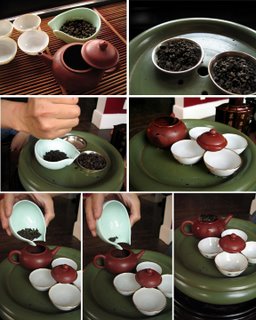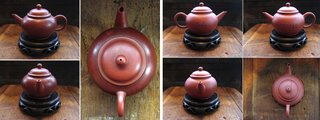


To carry-on my quest to Yixing pot's knowledge. I had chosen to shared my traditional Kung Fu pot. This pot was produced during the Chinese Culture Revolution in late 70's. And was one of the first tea pot which teaches me about traditional Cantonese / Fujian High Fire Kung Fu tea.
Using only Anxi North Cliff TGI, re-roasted and fired by Fujian tea master resides in Hong Kong, the liquor is one of the most intense and "Intoxicating". This traditional "Real" Kung Fu tea dated back more then 100 years ago in South East China: Hong Kong, Canton, Fujian and Chaozhou. The procedure to make 4 small cups are so complicated, people named it "Kung Fu Cha".
I had attached a step-by-step of my own simplify interpretation:
1. A 4 cups pot, thicker wall and lighter fired Zisha with a deeper/longer lid's footer.
2. Preheat everything with rolling boiled water.
3. Traditionally the amount of tea should be 3/4 full. Some elder tea aficionados even make 1:1 ratio of tea:water, which considered "Toxic" to me. I am using half a pot to suits my own tolerant.
4. Separating the bigger pallets to smaller in 2 piles.
5. Partially crushing the smaller pile by hand into powder and set aside.
6. Gently fill up the bottom with half the medium pallets, then center with crushed powder and topped with bigger pallets. There are many different methods to "build-up" the inside, but I found this one as my favorite and much easier then the traditional.
7. Hitting the water at the rim of pot, not directly into the center.
8. Rinse. Pouring in a circular motion into the cups and jerk 3 times at end of the pouring.
9. First infusion. Around 30 sec. Always pour water around the rim with low-arching position to avoid disturbing the tea configuration. Pouring back the rinse to "Kept" the pot and age the exterior.
10. I usually only do 3 infusions, and the last one is the most savored.
11. Using a "kept" pot brush to distributing the liquor evenly.
You can see this teapot wasn't so well maintained or "kept" over 30 years of usage. But it does has it's own character. I have another one which was made in the same period of time, using the same clay and quarry without any usage, because I dropped the lid! You can see and compare the aging process.
This style of pot is called "Aquarius" or "Balanced" pot. It is the most fundamental style which every good potters had to mastered before moving on. Only number were stamped inside (rarely) and "Made in Yixing" were stamped at the bottom. Also there are only one hole from the inside of the spout. During the Culture Rev. there are no potter's name stamped, and the factories are divided by numbers: 1. 2. 3. 5. etc since. Until recently, they started to become independently owned.

